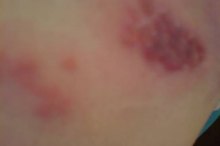What does fact checked mean?
At Healthfully, we strive to deliver objective content that is accurate and up-to-date. Our team periodically reviews articles in order to ensure content quality. The sources cited below consist of evidence from peer-reviewed journals, prominent medical organizations, academic associations, and government data.
The information contained on this site is for informational purposes only, and should not be used as a substitute for the advice of a professional health care provider. Please check with the appropriate physician regarding health questions and concerns. Although we strive to deliver accurate and up-to-date information, no guarantee to that effect is made.
Can Shingles Be on Both Sides of the Body?
Shingles is an infection most likely to strike the older population 1. It is caused by the chickenpox virus and can infect those who have previously been affected with chickenpox. Shingles is painful and usually attacks the trunk of the body 1. While shingles itself is not contagious, the virus can be passed on as chickenpox to someone who has not had the disease 1.
If you are experiencing serious medical symptoms, seek emergency treatment immediately.
What are Shingles?
Shingles is a painful infection caused by a virus that attacks the nerve roots 1. Shingles will attack the left side or the right side of the body and most commonly appears as a rash 1. Once infected, most people will get better and not get it again.
Causes
What Is the Incubation Period for Shingles?
Learn More
The cause of shingles is the herpes zoster virus, which is the chickenpox virus 1. If you have ever had chickenpox, you may develop shingles 1. Not all people who have had chickenpox develop shingles 1. After developing chickenpox, the virus enters the nervous system where it may lie dormant for many years. Then, for reasons which are unknown, it may reappear in the form of shingles 1. It is thought to be triggered by something such as stress, a weakened immune system or when disease occurs.
Appearance
Shingles may begin with flu-like symptoms, general achiness, headache or sensitivity to light 1. It then appears as rash, which is in a band or a strip that most often starts in the middle of the backbone and wraps itself around one side of the body to the chest. It does not attack both sides of the body. The rash is painful and itches. It turns into blisters that fill with fluid, break and then form a crust. It can be two to four weeks before the blisters disappear. There is also the possibility that the blisters may cause scaring.
- Shingles may begin with flu-like symptoms, general achiness, headache or sensitivity to light 1.
- It can be two to four weeks before the blisters disappear.
Am I Contagious?
Facial Herpes Symptoms
Learn More
You are contagious until blisters have scabbed over.
Prevention
You can take a step to prevent shingles if you are an older adult, 60 plus, who has had chickenpox and is at risk for developing the infection 1. It is a vaccine that can be given by your physician to eliminate or lessen the severity of the infection. Contact your family doctor to discuss this vaccine.
Treatment
If you think you may have shingles, contact your health care professional 1. She can prescribe treatment that will lessen the pain, help healing and prevent complications. Be sure to take the medications as prescribed and keep sores clean. The earlier treatment is begun, the better the outcome.
- If you think you may have shingles, contact your health care professional 1.
- She can prescribe treatment that will lessen the pain, help healing and prevent complications.
Related Articles
References
- WedMD: Shingles
- Mayo Clinic: Shingles
- National Center for Immunization and Respiratory Diseases, Division of Viral Diseases. Shingles (Herpes Zoster): Clinical Overview. Centers for Disease Control and Prevention. Updated August 14, 2019. cdc.gov
- National Center for Immunization and Respiratory Diseases. Shingles Vaccination. Centers for Disease Control and Prevention. Updated January 25, 2018. cdc.gov
- John AR, Canaday DH. Herpes Zoster in the Older Adult. Infect Dis Clin North Am. 2017;31(4):811-826. doi:10.1016/j.idc.2017.07.016
- Cohen KR, Salbu RL, Frank J, Israel I. Presentation and management of herpes zoster (shingles) in the geriatric population. P T. 2013;38(4):217–227.
- National Institute of Neurological Disorders and Stroke. Shingles: Hope Through Research. Updated August 13, 2019. ninds.nih.gov
- White PF, Elvir lazo OL, Galeas L, Cao X. Use of electroanalgesia and laser therapies as alternatives to opioids for acute and chronic pain management. F1000Res. 2017;6:2161. doi:10.12688/f1000research.12324.1
- Centers for Disease Control and Prevention. Chickenpox Vaccination: What Everyone Should Know. Updated August 7, 2019. cdc.gov
- InformedHealth.org [Internet]. Cologne, Germany: Institute for Quality and Efficiency in Health Care (IQWiG); 2006-. Shingles: Overview. 2014 Nov 19 [Updated 2019 Nov 21].Available from: https://www.ncbi.nlm.nih.gov/books/NBK279624/
- Albrecht, M. Shingles (Beyond the Basics). UpToDate. Updated June 12, 2019.
- Centers for Disease Control and Prevention. What Everyone Should Know About Zostavax. Updated January 25, 2018.
Writer Bio
Kathy Sheehan has been writing articles for a family owned health insurance website for the past four years. She works fulltime in the health care industry and is a licensed insurance representative. Kathy has published several articles for Demand Studios and writes about a variety of subjects. Kathy attended Sinclair Community College in Dayton, Ohio.







